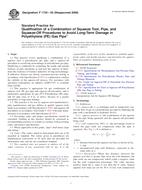Potrebujeme váš súhlas na využitie jednotlivých dát, aby sa vám okrem iného mohli ukazovať informácie týkajúce sa vašich záujmov. Súhlas udelíte kliknutím na tlačidlo „OK“.
ASTM F1734-03(2009)
Standard Practice for Qualification of a Combination of Squeeze Tool, Pipe, and Squeeze-Off Procedures to Avoid Long-Term Damage in Polyethylene (PE) Gas Pipe (Withdrawn 2018)
Automaticky preložený názov:
Štandardné praktiky pre kvalifikáciu kombináciu Squeeze Nástroj, potrubia a Squeeze-Off postupy pre zamedzenie dlhodobého poškodenia v polyetylénu (PE) plynového potrubia
NORMA vydaná dňa 1.8.2009
Informácie o norme:
Označenie normy: ASTM F1734-03(2009)
Poznámka: NEPLATNÁ
Dátum vydania normy: 1.8.2009
Kód tovaru: NS-51344
Počet strán: 4
Približná hmotnosť: 12 g (0.03 libier)
Krajina: Americká technická norma
Kategória: Technické normy ASTM
Kategórie - podobné normy:
Anotácia textu normy ASTM F1734-03(2009) :
Keywords:
damage, gas flow, pipe, polyethylene, squeeze, squeeze-off, tubing, Damage assessment, Gas flow, Long-term behavior/performance, Polyethylene (PE), Polyethylene (PE) pipe, Polyethylene (PE) tube, Squeeze-off materials/applications, ICS Number Code 23.040.20 (Plastic pipes)
Doplňujúce informácie
| Significance and Use | ||||||||||
|
Squeeze-off is widely used to temporarily control the flow of gas in PE pipe. Squeeze tools vary depending on the size of the pipe and the design of the tool. Squeeze-off procedures vary depending on the tool design, pipe material, and environmental conditions. Experience indicates that some combinations of polyethylene material, temperature, tool design, wall compression percentage and procedure can cause damage leading to failure. Studies of polyethylene pipe extruded in the late 1980s and thereafter show that damage typically does not develop when the wall compression percentage is 30 % or less, when temperatures are above 50°F (10°C), and when closure and release rates are typical of field conditions for screw-driven tools. With tools meeting Specification F 1563, acceptable flow control at typical gas service pressures is achieved at wall compression percentages between 10 and 20 % for pipe diameters less than 6 in. , Because damage does not develop in these materials at such squeeze levels, the references cited indicate that squeeze-off flow control practices using tools meeting Specification F 1563 and qualified procedures meeting Practice F 1041 are effective for smaller pipe sizes. , Note 3—Specification F 1563 provides a procedure for evaluating tool flow control performance. This practice provides a method to qualify a combination of squeeze tool, pipe size and material, and squeeze-off procedure to ensure that long-term damage does not occur. This practice is useful for polyethylene gas pipe manufactured before 1975, for new or revised polyolefin gas pipe materials, for pipe diameters of 8 in. or above, for new or revised squeeze tool designs, and for new or revised squeeze-off procedures. |
||||||||||
| 1. Scope | ||||||||||
|
1.1 This practice covers qualifying a combination of a squeeze tool, a polyethylene gas pipe, and a squeeze-off procedure to avoid long-term damage in polyethylene gas pipe. Qualifying is conducted by examining the inside and outside surfaces of pipe specimens at and near the squeeze to determine the existence of features indicative of long-term damage. If indicative features are absent, sustained pressure testing in accordance with Specification D 2513 is conducted to confirm the viability of the squeeze-off process. For assistance with specimen examination, an Adjunct, ADJF1734 , is available from ASTM. 1.2 This practice is appropriate for any combination of squeeze tool, PE gas pipe and squeeze-off procedure, and is particularly appropriate for pre-1975 Polyethylene (PE) pipe, and for pipe sizes of 8 in. or above, because of a greater possibility of long-term damage. 1.3 This practice is for use by squeeze-tool manufacturers, pipe manufacturers and gas utilities to qualify squeeze tools made in accordance with Specification F 1563; and squeeze-off procedures in accordance with Guide F 1041 with pipe manufactured in accordance with Specification D 2513. 1.4 Governing codes and project specifications should be consulted. Nothing in this practice should be construed as recommending practices or systems at variance with governing codes and project specifications. 1.5 Where applicable in this guide, “pipe” shall mean “pipe and tubing.” 1.6 Units—The values stated in inch-pound units are to be regarded as standard. The values given in parentheses are mathematical conversions to SI units that are provided for information only and are not considered standard. 1.7 This standard does not purport to address all of the safety concerns, if any, associated with its use. It is the responsibility of the user of this standard to establish appropriate safety and health practices and determine the applicability of regulatory limitations prior to use. |
||||||||||
| 2. Referenced Documents | ||||||||||
|




 Cookies
Cookies
